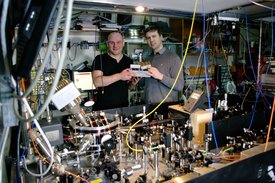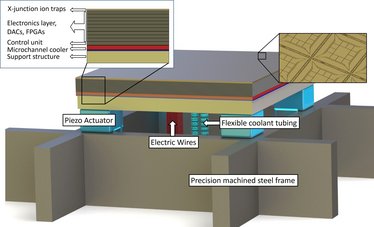Blueprint for a quantum computer available here - almost!
Quantum computers will be itsy-bitsy tiny, when they arrive - right? Wrong! At least the first ones will occupy an area of 100 by 100 meters according to to-day's paper published in Science Advances (1 February 2017). IFA's Klaus Mølmer is co-author of the paper. Grab a file and a quantum soldering iron, clear the parking area and get started!
An international team of scientists from the University of Sussex (UK), Google (USA), Aarhus University (Denmark), RIKEN (Japan) and Siegen University (Germany) have today unveiled the first practical blueprint for how to build a quantum computer, the most powerful computer on Earth.
The paper ‘Blueprint for a microwave trapped ion quantum computer’ by B. Lekitsch, S. Weidt, A.G. Fowler, K. Mølmer, S.J. Devitt, Ch. Wunderlich, and W.K. Hensinger is published in the journal Science Advances [Sci. Adv. 3, e1601540 (2017)] and the full article can be freely downloaded here not requiring a journal subscription.

Hensinger and Lekitsch showing their prototype computer unit and the simple test setup
In the article in the influential journal ‘Science Advances’ this new work features the actual industrial blueprint to construct such a large-scale machine, more powerful in solving certain problems than any computer ever constructed before.
The computer is based on trapped atomic ions and the work features elementary operations, so-called quantum gates, originally developed for use with lasers more than a decade ago in Aarhus, but applied here in a revised scheme that uses microwave fields. The physical processes are carried out on atomic ions forming a so-called surface code that makes it possible to recover information stored in the ions, even if some of them are lost or undergo erroneous processes. All calculations take place by moving the ions back and forth to interact with their nearest neighbours by switching on microwave fields.
 A little help to get you started in the garage
A little help to get you started in the garage
The blueprint shows a modular design of identical components that can be put together to form a system of arbitrary size. Previously, scientists have considered using fibre optic connections to connect individual components of larger computer architectures. The new approach introduces connections created by electric fields that allow ions to be transported over short distances from one module to another. This new approach allows 100,000 times faster connection speeds between individual quantum computing modules compared to current state-of-the-art fibre link technology.
The new blueprint is the work of an international team led by experimentalist Winfried Hensinger at the University of Sussex, England, who is currently building the first prototype modules: “For many years, people said that it was completely impossible to construct an actual quantum computer. With our work we have not only shown that it can be done but now we are delivering a nuts and bolts construction plan to build an actual large-scale machine.”
Klaus Mølmer adds: "Each module is 9 x 9 centimeters and will trap almost 1300 atoms. Building an array of modules some 100 by 100 meters large will enable us to catch and handle a bit less than one billion atoms, and the system will be self controlling, allowing at the most 1% error operations that can be corrected. The invention of this type of quantum gate for atomic ions was invented by Andres Sørensen and myself 16 years ago. We used lasers for control and signal processing. This new version utilizing micro waves and magnetic fields is much easier to set up and use."
